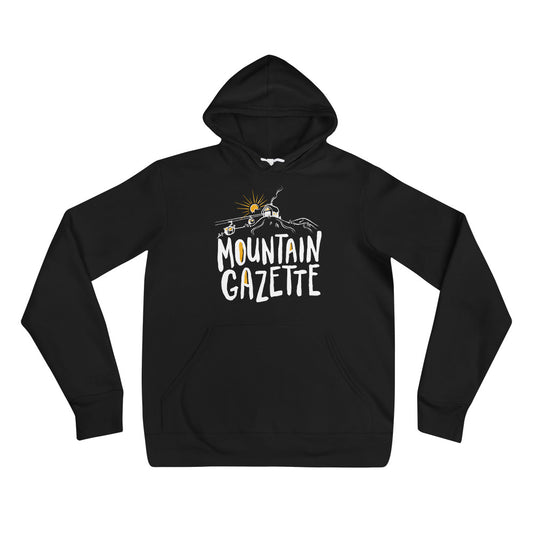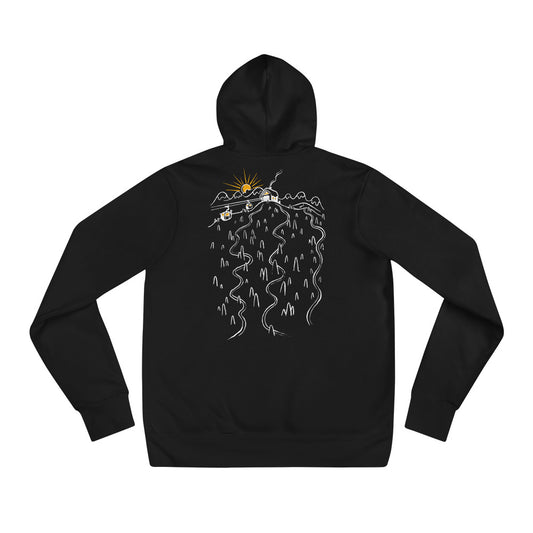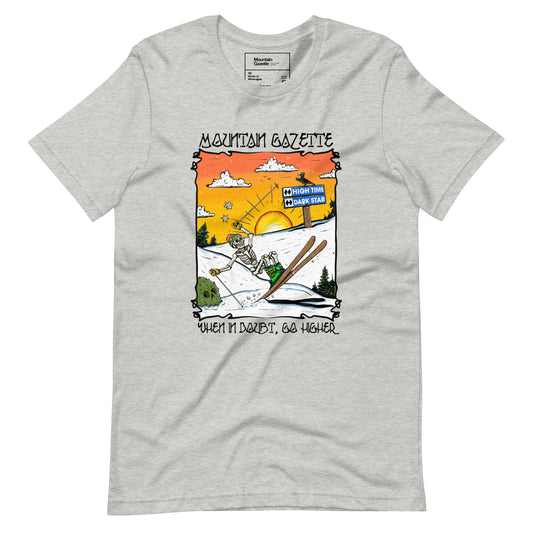By Aaron Thomas Philips
This story was originally published on MountainGazette.com in 2011. We're revisiting it here for readers of the Sunday Newsletter. Subscribe to the newsletter here.
1. Unmooring
On some days, you sit and look at the computer. Your fingers touch the keys and go nowhere. Your mind numbs as symbols collide on the screen. On some days, this all makes perfect sense. You have things to do. You are bound, chained. But on other days, there’s that cold wet black nose that nudges your elbow as you drone on. That nose is never wrong. It calls you from complacency: “I need to go out, to roam! This nose must hunt, must cover new territory! This is what I must do.”
The nose is attached to Riley, 75 pounds of four-legged tawny brawn. For this beautiful canine eunuch, ranging, roaming and alarmingly indiscriminate eating are the only patterns worth repeating. Patterns like the awkward totter of bipedal motion, the curse of obsessive cognition and the maze of symbols spewed across a computer screen are of no use to him.
At 2 p.m., you will be knee-deep still in work, but the nose will prevail. It will cause an awakening, a resurgence of the hunter-gatherer within. Prompted by sidekick, modern man goes mini-paleolithic, shuts down computer and leaves warm house, bent on Winter Solstice hike.
2. Ascending
At 8,300 feet above sea level, Grandeur Peak’s height is much more attainable than that of its loftier sister mountains that jut skyward east of Salt Lake City. Most days, it’s a pretty good choice for roaming with Riley. During the winter, snowshoers’ tracks make the path easily negotiable with simple hiking boots. Dog paws work great too. And the view is outstanding at sunset, particularly when the haze of particulate matter that favors the valley broadens the typical palette of dull reds and oranges. Seemed like the right destination, given the few hours we had until darkness.
Bound for Grandeur, Riley and I loaded up and went to pick up his cousin Sandy. Sandy is my brother’s dog, a labweiler (Labrador Retriever meets Rottweiler; the two fall in love; they make labweilers). Sandy and Riley’s relationship unfolds along distinctly canine lines. Riley’s the upstart male, heckling, herding and worrying the larger, stronger Sandy until she corrects him decisively. This cycle repeats.
On the car radio, the announcer prated on about snow: snow tonight, snow impending, three inches of snow, snow in the valley, snow warning, snow advisory, winter storm watch. The forecast had featured snow for days, and never once had reality reflected the forecast. So I paid no mind to this sober warning, though the wind had been gusting all day. I had heard the swamp cooler cover twisting in the wind, I had felt the raw push of the wind shake the wood frame of the house, yet I had remained skeptical.
The line between skeptical and ill-advised is sometimes a thin one. But we nevertheless entered the V-shaped confines of Mill Creek Canyon, home of the Grandeur Peak trailhead. We piled out. Riley and Sandy, unconcerned about the pitch of the terrain, bounded ahead, working as a pair, negotiating a maze of scrub oak, nipping, charging full tilt. I stomped up the trail, watching carefully to see where they would relieve themselves so I could make things right with a plastic doggie dookie bag.
Wind was strangely absent from the canyon. The air was stirring only lazily, its torpor a sharp contrast to the fury of wind scouring the valley. As we rose upward, leaving the initial canyon of Church Fork for a series of switchbacks up a sort of hanging valley, I looked southward at Olympus, at Raymond and at Twin Peaks, masses of stone and earth. Cirrocumulus clouds skittered across their faces, sucked inevitably northward into the looming low pressure.
No matter. I was sure the storm was taking its sweet time, and I still didn’t believe it would produce snow. We pressed upward, zigzagging our way up the mountain’s south flank. The dogs had not yet begun to scrub off the excess energy that fueled their frenetic play, now pouncing, now dodging, now bolting down the trail to a place I had been fifteen minutes before in a tenth of the time, only to return to me, tongues lolling.
Just under an hour, and I had huffed my way to a ridge that overlooks Parley’s Canyon, named for Parley Pratt, an Mormon pioneer with a capitalist knack for creating toll roads through eponymous landforms. The peak was maybe twenty minutes away, and the view into Parley’s Canyon was pretty clear. So we might as well continue on. The dogs charged ahead, live wires still, and I began booting up the steepening — and deepening — snow.
I wallowed (and the dogs frolicked) southwest up the ridge that meanders to the summit. As the ridge curves southward, hikers are generally treated with a commanding view of the Salt Lake Valley. Not so today. The wind, in its implacable persistence, had eventually succeeded in ushering into the valley a cloud whose proportions defied my sense of measurement. In place of the valley
was an immense blackness, a nightmare cloud.
The cloud looked to be contained in the valley, hugging its floor and enveloping its inhabitants, content with disrupting the impending rush hour traffic rather than ascending to the aerie from which I watched its menacing — but apparently slow — progress. So of course we continued upward. Ten minutes later, within 200 meters of the summit, I was corrected. A gust of wind, the velocity of which was unmistakably north of 60 miles per hour, sent me reeling. And I realized that this wind, being sucked into the vortex of cloud into the valley, would exercise a return pull on the low pressure, which translated to this place being enveloped in cloud. And soon. The wind had finally pierced through to my deeply buried common sense, playing Sandy to my Riley: You’re pushing my limits. Knock it off already.
So we turned around. Suddenly, the top of the mountain seemed a profoundly stupid place to be spending any length of time. Couch, hot tub, Afghanistan, all began to seem like better alternatives. I tromped downward, soon reaching the spot where I had moments before seen the black cloud. It had been replaced by a rush of oncoming white, a wall of wind and snow.
I couldn’t ignore a certain fascination with the approaching blanket of wind-whipped snow. I knew by now I was not going to outrun this storm, so I let it overtake me. Standing on the ridge, I whooped with a visceral excitement as I was engulfed by the storm. I had never witnessed a frontal passage this defined. The swirling mass of white poured over the ridge, over me and the wholly unconcerned dogs, and spilled into the canyon below. Visibility: zero.
3. Of moths and flames
Traveling in the Sierra Nevada on a crust of bread and a prayer, writer and adventurer John Muir once climbed a tree to get closer to one of the sublimely powerful electrical storms that often besieged his mountain retreat. When the first lightning strike came, I realized just how peculiarly unconcerned with life and limb Muir was — and therefore how unlike me he was. While I had reveled in the mildly Muirish moment of having the storm pass before my eyes and immediately cloud my perspective, I unequivocally drew the line at lightning. What was lightning doing in a snowstorm, anyway?
The strike had happened, I thought, somewhere toward the Parley’s Canyon side of the ridge. Too close. I ran. The dogs were in front of me, but were stalling, tentatively looking back, wondering why I had become a madman. I shouted at them, “up, up, up,” thinking they might understand this to mean hey-we-need-to-get-the-hell-off-this-mountain-and-fast. But they still lagged, concerned by my sudden lack of sanity. I hurtled down the trail, post-holing at times to mid-thigh, flopping back onto the snow, flounder-like, getting up, running again, falling again.
Again lightning struck. Again too close. I looked like Hawkeye in the television show “M*A*S*H”, ducking low to avoid a chopper’s rotors. Ridiculous — I was still the highest, most conductive thing on this ridge, and lightning would not pass me by on account of this half-assed slouching. I hadn’t noticed it on the climb up, but much of the last mile or so of the trail is exposed, the only trailside flora stubby, leafless Gambel Oak, no buffer whatsoever. Images of Ben Franklin’s ill-advised but ground-breaking experiments with lightning flashed through my mind. But in my frightened mind’s eye, I was the electrified kite, not the flier.
More flashes, the cloud above me glowing orange, hair standing on end quite literally, and running at a faster clip than I have since, well, ever, are my trauma-scattered memories of the rest of the trip down. I stumbled over dogs; I cursed; I struck a prayerful bargain with god/buddha/universe/to whom it may concern; I twisted my knee and didn’t care; and finally I made it to lower ground. The succor might have been psychological only, as I knew a grove of tall trees wasn’t a great place to be, but at least the lightning would have options — other life forms to snuff out on its way to the ground.
Fifty minutes from turnaround point to parking area. Fifty of the most intensely felt minutes I have experienced on this earth — the drive back into the valley coming in a close second, the road having been covered by four inches of snow and made virtually un-navigable. Looking back, I know that Franklin and Muir were both madmen, if geniuses. And I know why we fear and yet still seek out lightning, with its alien power and effortless mastery of humans and our frail ingenuity. There is something in nature, in its deadly power, we must come closer to if we are to understand the audacious tenuousness of life. We are drawn to its truth.
4. Home, awake, recharged
You will realize that those near-misses, those jolts of unknowable energy that writer and strike survivor Gretel Ehrlich calls “a match to the heart,” had the power — terawatts of it — to scare you into a heightened sense of the unmitigated beauty of being alive as opposed to dead. You will be thankful for the lightning’s way of recharging your vitality, delivering a surge of power to scare you out of, and back into, your animal skin.
But you will not climb that mountain in a storm again. Ever.
Aaron Phillips is based in Salt Lake City, where he teaches writing at the University of Utah. He flees to — and from — high elevations with his canine guide whenever possible.
















